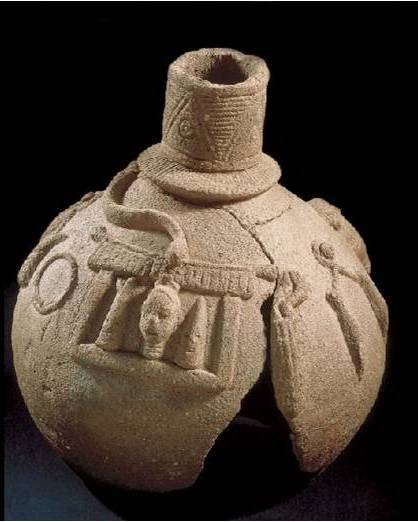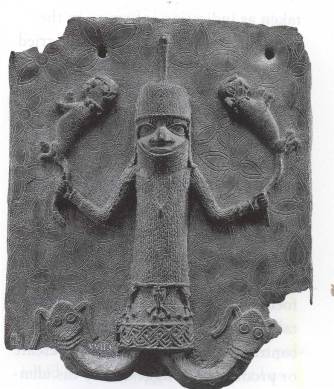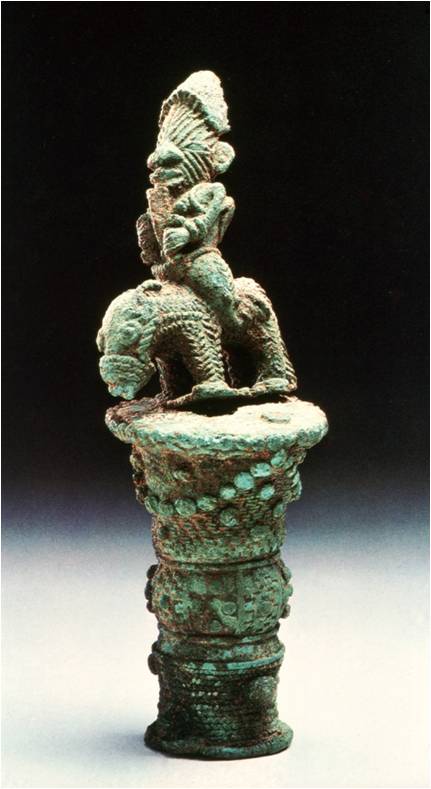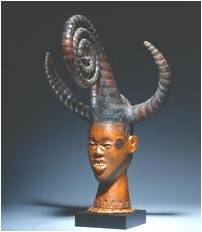Cards In This Set
| Front | Back |
 1. |
1. El Anatsui2. Old Man's Cloth3. 20034. Ghana/Nigeria5. Aluminum and copper wire6. Wall sculpture7. Anatsui used recycled materials together to represent the woven materials and rich textiles from Ghana and Nigeria. The folds and textured surfaces create movement and imitate the way a draped flowing fabric would look.
|
 2. |
1. Arshanti people2. Sika Adwa or The Golden Stool of Asante3. 1700s 4. Ghana5. Gold6. Shrine and ceremonial purposes7. It was known to be supernatural because it fell on the lap of Osei Tutu, the first Ashantehene. It protects the soul of the new nation. It contains the essence and history if the Asantes.
|
 3. |
1. Ashanti2. Akuaba doll3. 20th Century4. Ghana5. Wood6. Women who wished to become pregnant would care for an akuaba doll.7. Symbolized the common African motif of procreation and the desire to reproduce. Women carried it by continuing their beliefs in their respective spiritual system, in hope to conceive a child.
|
 4. |
1. Sapi-Portuguese2. Lidded Saltcellar3. 15th-16th Century4. Sierra Leone5. Ivory6. The saltcellar was used by the Sapi for trade with the Europeans, primarily the Portuguese. The Europeans used it to hold spices or salts.7. The significance of the Saltcellar can be found in the medium, engraving style, and basic construction. Ivory was seen as extremely valuable for trade and the engravings were done by the Sapi people but have a lot of European artistic attributes. The construction of the saltcellars has a lid and is more deep it was intended to be used for trade purposes.
|
 5. |
1. Yoruba2. Mask3. Pavement Period 12th-15th Century4. Nigeria5. Copper/Bronze6. Because it is made of copper and heavy, we aren't sure if it was worn but there's holes in the eyes so it could have been worn.7. Proves the pertinence of masquerades and the role they play in the spiritual makeup of African society. It also conveys the relevance in African cultures of casting, welding, and sculpting.
|
 6. |
1. Yoruba2. Ritual Vessel3. 13th-14th Century4. Nigeria5. Terracotta6. Used during rituals a sacrifice was poured through the pot. the contents are poured onto the ground to offer thanks. 7. The two abstract heads are carved together on purpose to show both the inner and outer head. the spiky head and the cone head represent the inner (psych and soul) and the naturalistic head represents the outer.
|
 7. |
1. Igbo2. Ikenga Personal Altar3. Early 20th Century4. Nigeria5. Wood6. Used in a personal shrine or obi. 7. Represents both ones ancestors and ones chi. Symbolizes ones own god who can approach the supreme deity.
|
 8. |
1. Benin2. Plaque3. 16th-17th Century4. Nigeria5. Bass6. Used as a propaganda, to celebrate the power of the King and to show the wealth of the society and trade with the Portuguese.7. The leopards, shown as being swung by the King, symbolize power and strength of the King because they're the king of the forest in Benin. The mudfish show versatility because they are able to travel both by land and water and signifies that the King's power extends both over land and sea.
|
 9. |
1. Nri2. Staff Finial/ Flywhisk Handle3. 9th-10th Century4. Igbo Ukwu, Nigeria5. Leaded Bronze6. Flywhisk handle and staff finial7. The casting implies both travel and trade. Horses are associated with leaders and title-taking. The rider's face displays scarification, called ichi, which is still linked with both titles and the Nri people.
|
 10. |
1. Cross River Region2. Crest Mask3. N.D.4. Nigeria5. Wood, stained animal skin, basketry6. Used mainly in masquerades for funerals and initiation of new members. Wore on top the head attached to a basketry cap held by a chinstrap.7. Represents the ideal beauty of a woman in its long neck, towering coiffure, assemblages of various materials and scarification patterns.
|



